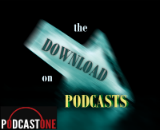The Download on Podcasts is a weekly feature sponsored by PodcastOne.
Advertisers are interested in the marketing opportunity of podcasts, and will get more serious about it if audience measurement improves. Those are the main points of new research conducted by Westwood One, Advertiser Perceptions, and Ipsos, just released by Westwood One in its blog.
Several points inform the research results. First is listener retention of marketing messages. According to Ipsos, 65% of listeners remember sponsorship messages they heard in podcasts the day before. Nearly half retain the messaging for a week.
On the buy side, 41% of surveyed advertisers in the 2015 Omnibus study by Advertiser Perceptions have discussed podcasting, with 15% of surveyed marketers advertising in podcasts already. The latter number seems more impressive than the former — with podcasting in the media trades every day, how can advertisers and agencies not be talking about it in their meetings?
Anyway, less than one-fifth of respondents in that study said they “definitely would consider” advertising in podcasts, and a greater percentage (27%) said they “definitely would not consider.” That’s not a gleaming result either.
Westwood One is not framing that response disparity as a problem, but in hoping for a positive shift we might productively ask what the problem is.
The research answers that question indirectly in a Westwood One focus group, which was asked “what podcasters need to do.” The reported answers, unsurprisingly, center around better measurement, audience definition, and demonstration of value.
In the current podcast resurgence, which is about two years in progress, measurement is widely cited as a pain point that affects publishers telling a story to marketers, and buyers trying to define highly engaged audiences. One reason that direct-response marketing holds forth to a large extent in podcasting is that the response can be measured with coded calls to action. So an advertiser can experiment with “Go to OurCompany.com/ShowName for a 20% discount on your first order.” The convertible audience is defined during the campaign, not before it.
Individual podcast hosts can measure audience behavior on their servers, but with many different clients making those server calls (of which iTunes and its podcast-specific iOS app are the leaders), more granular information about starts, stops, and completions is hidden from producers and networks. Overall, standardization is absent, so advertisers cannot relate one network’s metrics to another’s or easily gain a picture of one total audience for a show or for the whole category.
Initiatives to solve the problem have been announced by Triton Digital with Edison Research, and AdsWizz. But standardization in a competitive market can be elusive, as the audio market generally knows very well. Podcasting has enormous potential to deliver attentive, engaged audiences. The Westwood One study demonstrates that marketers are becoming aware of the potential, but need real progress on the sell-side before they will dive in.

